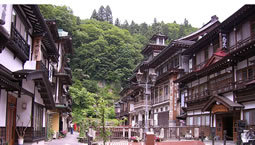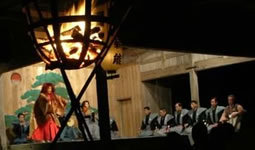Active Tours - Tour Designers Office
INDEX
INDEX

Mythological World is an important element of every nation and tribe in the world. Every nation has mythology conveyed from generation to generation.
In Japan, “Shinto = Kami-Worship” is the world of mythology, later combined with Buddhism, which could reinterpreted the internal aspects of mythological persons. Buddhism in Japan is a religion indispensable to the spirits of Kami-Worship. There are shrines and temples where ancient people felt as the “spiritual spot”, where are often in the depth of woods or on the top of mountains.
13-day Tour from Tohoku area, through Sado Island to Kyoto
Visiting places full of myths and legends, in the midst of nature, by rail, ferry, rope-way and coach.
The program includes 3 big religious places, Dewa-Sanzan, Eihei-ji & Mt. Koya. Sado-Island will give visitors something unique experience.
In Japan, “Shinto = Kami-Worship” is the world of mythology, later combined with Buddhism, which could reinterpreted the internal aspects of mythological persons. Buddhism in Japan is a religion indispensable to the spirits of Kami-Worship. There are shrines and temples where ancient people felt as the “spiritual spot”, where are often in the depth of woods or on the top of mountains.
13-day Tour from Tohoku area, through Sado Island to Kyoto
Visiting places full of myths and legends, in the midst of nature, by rail, ferry, rope-way and coach.
The program includes 3 big religious places, Dewa-Sanzan, Eihei-ji & Mt. Koya. Sado-Island will give visitors something unique experience.
The Ginzan-onsen Hot Spring Located along the Ginzan River in Yamagata. Graceful three- and four- story wooden inns stand in rows on both sides of the river, with its streaming crystal clear waters, giving the area an air of a hermitage village. Ginzan, meaning "silver mountain," was so named because of a silver mine discovered there around 500 years ago.
Sado Island
Japan’s fifth-largest island with distinguished history and culture, influenced by the three most prominent figures sent into exile to this island. They were the former emperor Juntoku, the Buddhist monk Nichiren, and the founder of Noh, Zeami. Today we can find many Noh stages and from spring to autumn, there are a lot of Noh performance, at shrines and temples. Sado Kinzan (gold and silver mine) was the most productive mine in Japan during the Edo Period and served as a major source of income for the Tokugawa Shogunate, and was under its direct control.
Japan’s fifth-largest island with distinguished history and culture, influenced by the three most prominent figures sent into exile to this island. They were the former emperor Juntoku, the Buddhist monk Nichiren, and the founder of Noh, Zeami. Today we can find many Noh stages and from spring to autumn, there are a lot of Noh performance, at shrines and temples. Sado Kinzan (gold and silver mine) was the most productive mine in Japan during the Edo Period and served as a major source of income for the Tokugawa Shogunate, and was under its direct control.
Koya-san (Mt. Koya)
Center of Shingon Buddhism, an important Buddhist sect which was introduced to Japan in 805 by Kukai (known as Kobo-daishi), one of Japan’s most significant religious figures, along with Saicho (known as Dengyo-daishi) who build up Tendai Buddhism in Enryaku-ji. Over 100 temples stand in the small town on the mountain top, surrounded by a thick forest. The mausoleum of Kobo-daishi is the start and end point of the Shikoku 88-temple pilgrimage.
Koya-san is the best place to experience an overnight stay at ‘shukubo’ (temple lodging), where visitors can touch with monks lifestyle, eating ‘shojin ryori’, vegetarian monks’ cuisine.
Center of Shingon Buddhism, an important Buddhist sect which was introduced to Japan in 805 by Kukai (known as Kobo-daishi), one of Japan’s most significant religious figures, along with Saicho (known as Dengyo-daishi) who build up Tendai Buddhism in Enryaku-ji. Over 100 temples stand in the small town on the mountain top, surrounded by a thick forest. The mausoleum of Kobo-daishi is the start and end point of the Shikoku 88-temple pilgrimage.
Koya-san is the best place to experience an overnight stay at ‘shukubo’ (temple lodging), where visitors can touch with monks lifestyle, eating ‘shojin ryori’, vegetarian monks’ cuisine.
|
Day 1
Narita Int’l airport arrival | Tokyo |
Meet and greet by a guide and transfer to Tokyo. City tour, visiting Asakusa (Senso-ji & Nakamise) and Tokyo National Museum. (Tokyo)
|
|
Day 2
Tokyo |
Morning, visit Meiji Shrine for private purification and enjoy “Kagura” dance & music. Then visit Imperial Palace Garden, and others. (Tokyo)
|
|
Day 3
Tokyo | Yamagata | Ginzan Onsen |
Board on JR bullet-train to Yamagata, then take a car for Yama-dera (temple), date back to 860AD. This is one of the most significant sacred sites in the Northeastern Tohoku region in Japan, capturing the attention of an enormous number of the faithful. 1015 stone stairs will bring you to the world of meditation. (Ginzan Onsen) |
|
Day 4
Ginzan-Onsen | Mogami River Cruise | Dewa Sanzan |
Today, enjoy Mogami-river cruise for around 60minutes. Then,
visit Dewa Sanzan (three mountains), starting from Haguro-san, then to Gassan, date back to 593 ? 605 AD. Overnight at “Shukubo”, sub-temples providing visitors with accommodation with Shojin-ryori dinner. (Haguro-san) |
|
Day 5
Dewa | Sanzan | Sakata |
Morning visit the third temple, Yudono- san.
Then to Sakata, which lies at the mouth of the Mogami river and was the gateway for goods to and from Kyoto area, and consequently rich in culture and history. The local dialect sounds similar to that of the Kyoto region. (Sakata) |
|
Day 6
Sakata | (Niigata) | Sado Island |
Leave for Niigata by JR train, enjoying picturesque coastline of the Sea of Japan from windows.
Upon arrival at Niigata, take a ferry to Sado Isaland, with distinguished history and culture all its own. (Sado) |
|
Day 7
Sado Island
|
Full-day tour of Sado, visiting former Gold Mine, Homma Noh-butai (stage), Shukunegi village, and others. *Sado is a thriving place of Noh performance, and there may be a chance of watching “Takigi Noh” (Noh performed outside in the light by bonfires. (Sado) |
|
Day 8
Sado Island
| (Naoetsu) | Kanazawa |
Take a ferry for Naoetsu, then board on JR train for Kanazawa.
Again, enjoy panoramic view of the sea of Japan. Upon arrival Kanazawa, tour of Castle and Kenroku-en Park, Samurai ward and others, to get in touch with fabulous Kaga Culture. (Kanazawa) |
|
Day 9
Kanazawa | Eihei-ji | Kyoto |
Leave for Eihei-ji Temple, the head temple of the Soto-sect of Zen Buddhism, founded by Dogen-zenji in 13th century on the mountain hill. It is an active monastery with around 150 practicing Zen monks, and even foreigners can stay here overnight to follow the monks’ daily routine. Transfer to Kyoto either by JR train or by coach. (Kyoto) |
|
Day 10
Kyoto |
Full-day tour of Kyoto, visiting Sanju-sangen-do, Kiyomizu-dera, Kinkaku-ji & Shimogamo Shrine. Visit includes tea-ceremony experience. (Kyoto) |
| Day 11 Kyoto | (Osaka) | Koya-san (Mt. Koya) |
Leave for Mt. Koya via Osaka by JR train and cable-car.
Visit Okuno-in, the mausoleum of Kukai (Kobodaishi). On the both sides of cemetery path, a half million tombs develop impressive aspect. Then visit Kongo-bu-ji complex, head-quarter of the Shingon-shu (sect). Overnight at “Shukubo” in Koya-san, with “Shojin-Ryori” Dinner |
| Day 12 Koya-san | Osaka |
Early morning, participate in the !morning prayer’ with fire ceremony which are held in solemn atmosphere, and as if our spirits to be washed away. After lunch, descend the mountain by cable-car and train for Osaka. (Osaka)
|
| Day 13 Osaka | Kansai Int’l Airport (KIX) |
Transfer to Kansai International Airport by coach.
Tour ends at airport. |








